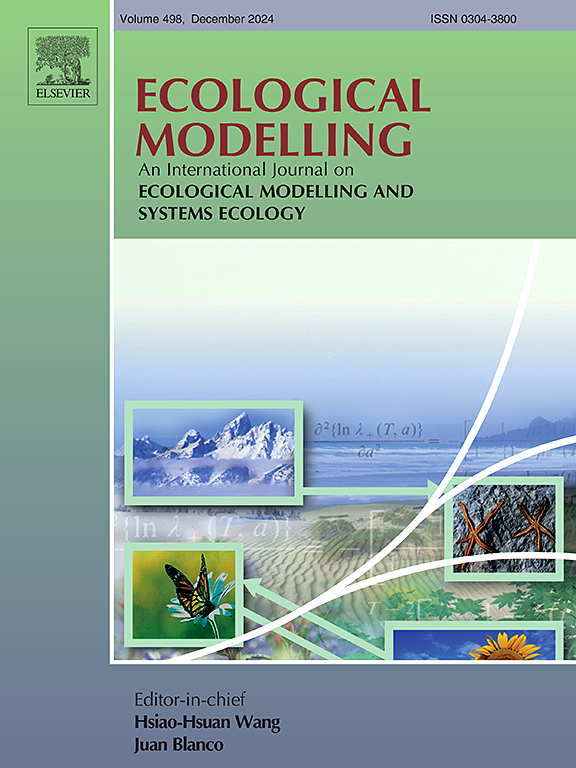Elasmobranch vulnerability to global warming: insights from bioenergetic modelling of catsharks under climate scenarios
IF 3.2
3区 环境科学与生态学
Q2 ECOLOGY
引用次数: 0
Abstract
Ectotherms are especially vulnerable to global warming due to their temperature-sensitive metabolic processes, impacting survival and reproductive success. Elasmobranchs, with slow life histories and low reproductive rates, may face amplified risks. In this study, we investigated two catshark species with distinct life traits and distributions: the Small-spotted Catshark (Scyliorhinus canicula) and the Nursehound (S. stellaris). Using newly calibrated bioenergetic models, we assessed changes in growth, sexual maturity, offspring production, and population dynamics under two CMIP6 climate scenarios projected for 2100: SSP2–4.5 (Middle of the Road) and SSP5–8.5 (Fossil-fueled Development), comparing these to historical data (1994–2015). Survival rates for early life stages remained similar under historical temperatures (80 %) and SSP2 (83 %) but dropped sharply under SSP5 to 33 % for S. canicula and 23 % for S. stellaris. Under both SSP2 and SSP5, S. canicula showed slight delays in maturation, yet the proportion of mature individuals ultimately exceeded historical levels in SSP2. Conversely, S. stellaris experienced progressively delayed maturation with warming. In SSP5, reduced growth, reproduction, and survival caused a population crash for S. stellaris, suggesting potential extinction. Our results reveal contrasting climate impacts on these species, underscoring the risk for late-maturing, low-fecundity, and narrowly distributed species. This emphasizes the urgency of conservation strategies tailored to mitigate their vulnerability to global warming.
猫鲨对全球变暖的脆弱性:气候情景下猫鲨生物能量模型的见解
变温动物特别容易受到全球变暖的影响,因为它们对温度敏感的代谢过程会影响它们的生存和繁殖成功。具有缓慢生活史和低繁殖率的蓝鳃亚目可能面临更大的风险。本研究调查了两种生活特征和分布各异的猫鲨:小斑点猫鲨(Scyliorhinus canicula)和护理犬(S. stellaris)。利用新校准的生物能量模型,我们评估了2100年CMIP6预测的两种气候情景:SSP2-4.5(中间道路)和SSP5-8.5(化石燃料发展)下的生长、性成熟、后代生产和种群动态的变化,并将其与1994-2015年的历史数据进行了比较。在历史温度下(80%)和SSP2下(83%),早期阶段的存活率保持相似,但在SSP5下急剧下降,canicula为33%,stellaris为23%。在SSP2和SSP5的作用下,木螺的成熟时间略有延迟,但成熟个体的比例最终都超过了SSP2的历史水平。相反,随着气候变暖,星参的成熟时间逐渐推迟。在SSP5中,生长、繁殖和生存的减少导致了S. stellaris种群的崩溃,表明可能灭绝。我们的研究结果揭示了气候对这些物种的不同影响,强调了晚熟、低繁殖力和分布狭窄的物种的风险。这强调了制定保护策略的紧迫性,以减轻它们对全球变暖的脆弱性。
本文章由计算机程序翻译,如有差异,请以英文原文为准。
求助全文
约1分钟内获得全文
求助全文
来源期刊

Ecological Modelling
环境科学-生态学
CiteScore
5.60
自引率
6.50%
发文量
259
审稿时长
69 days
期刊介绍:
The journal is concerned with the use of mathematical models and systems analysis for the description of ecological processes and for the sustainable management of resources. Human activity and well-being are dependent on and integrated with the functioning of ecosystems and the services they provide. We aim to understand these basic ecosystem functions using mathematical and conceptual modelling, systems analysis, thermodynamics, computer simulations, and ecological theory. This leads to a preference for process-based models embedded in theory with explicit causative agents as opposed to strictly statistical or correlative descriptions. These modelling methods can be applied to a wide spectrum of issues ranging from basic ecology to human ecology to socio-ecological systems. The journal welcomes research articles, short communications, review articles, letters to the editor, book reviews, and other communications. The journal also supports the activities of the [International Society of Ecological Modelling (ISEM)](http://www.isemna.org/).
 求助内容:
求助内容: 应助结果提醒方式:
应助结果提醒方式:


